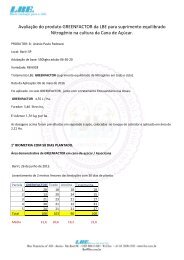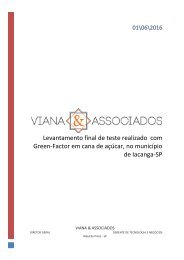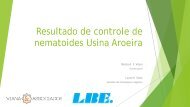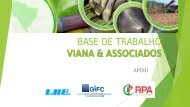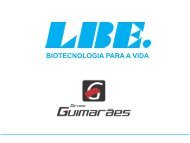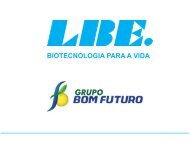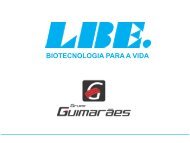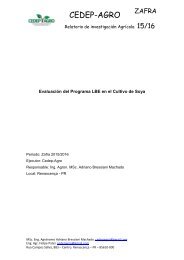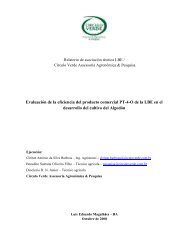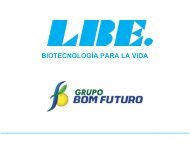22 - upf trigo-aveia-cevada Inglês
You also want an ePaper? Increase the reach of your titles
YUMPU automatically turns print PDFs into web optimized ePapers that Google loves.
AGRONOMY AND VETENARY MEDICINE<br />
PASSO FUNDO UNIVERSITY<br />
Campus São José - CP 566, CEP 99001-970 – Passo Fundo, RS<br />
Phone: +55 54 316 8167<br />
Passo Fundo, 12th February 2006.<br />
Dear Sir.<br />
We are sending the results of the use of PT4-O, Turboflower and AVE, in<br />
white oat, beer barley and wheat cultures, harvest 2005.<br />
We believe that the yield could have been better if the treatment of the<br />
seeds were done with fungicides and insecticides, since, especially in the barley;<br />
there was a high incidence of VNAC in the beginning of the culture development.<br />
Another aspect that has affected in a negative way the culture’s yield was<br />
the intense rain of October (approximately 400 mm), in the period of grain<br />
stuffing and maturation.<br />
However significant differences were verified among the various<br />
treatments evaluated, when compared to the control.<br />
We would be glad to provide further explanations.<br />
We are also sending the receipt of the contract second parcel’s payment,<br />
due on April 3 rd 2006.<br />
We look forward to hearing from you.<br />
Yours sincerely,<br />
Prof. Dr. Elmar Luiz Floss<br />
Researchers<br />
Ilmo. Sr.<br />
JOSÉ GUERRA<br />
Director of – LBE – Biotechnology to life,<br />
FLORIANÓPOLIS – SC.<br />
1
THE EFFECTS OF THE LBE PRODUCTS ON THE WHITE OAT (cv. UPFA 20 –<br />
Teixeirinha) CULTURE IN PASSO FUNDO, HARVEST 2005.<br />
INTRODUCTION<br />
With the greater economic importance of the white oat culture (Avena sativa L.) in the South<br />
region of Brazil, new technologies are been created to guarantee a rise of productivity, a better<br />
industrial quality and profit-making on this culture. Among these technologies are the products<br />
developed by the LBE, through seeds and foliar treatments.<br />
The beneficial effects of these chemical products, over the economic point of view, depends<br />
on many factors, including the kind of soil, the yielding potential of the seeds, the climatic<br />
conditions of the region and the agricultural practices used by the producers.<br />
The aim of this project was to evaluate the commercial products AVE-O and Turboflower<br />
applied to the aerial part and PT-4-O, seeds way, regarding the yield, industrial quality and other<br />
characteristics of the white oat seeds UPFA 20 – Teixeirinha.<br />
METHODOLOGY<br />
The experiment was conduced at the Experimental Camp Of the Agronomy and Medicine<br />
Faculty of the Passo Fundo University, at dystrophic Red Latossoil (latossolo), typical clay texture,<br />
which belongs to the mapping unit “Passo Fundo”. The soil pH was previously corrected and the<br />
experiment was done with a density of 350 able seeds per squared meter. A manuring of 310 kg/ha –1<br />
of the formula: 5-25-25 was done and also a nitrogen manuring of urea, at the stage of 4 expanded<br />
leaves.<br />
The experimental outline used was of random blocks, in four repetitions. Each parcel was<br />
made of 7 lines, 5 meters long, 0,17 m space between the lines and 5 m between the parcels.<br />
The caterpillar and aphids control was done using the application of the insecticides Talcord<br />
(200 mL.ha -1 ), Perfection (400 mL.ha –1 ) and Connect (150 mL.ha -1 ). The control of weeds was done<br />
through the application of bentazon (Basagran, 1,2L.ha-1), at the stage of sprouting.<br />
The experiment consisted of 5 treatments: 1) Control; 2) PT-4-O (seed treatment); 3)<br />
Turboflower (applied at the end of the sprouting); 4) AVE-O + Opera with a dosage reduced by 20%<br />
(start of the blossom); 5) Opera (in normal dosage of 500mL. ha -1 ), at the start of the blossom. In the<br />
treatment of the seeds the product PT-4-O was used, at the dosage of 150ml/100kg of seeds. In the<br />
treatments 1, 2 and 3 an application of the fungicide tebuconazole (Folicur, dose of 750mL. ha -1 ),<br />
applied at the stage of the beginning of the blossom, aiming the control of illnesses of the aerial part<br />
of the plants.<br />
The foliar treatments were done using a costal pulverizer, with constant pressure of CO 2 ,<br />
application the Turboflower, in the dosage of 1 liter per ha, at the final stage of sprouting and AVE-<br />
O (250mL.ha -1 ), together with the fungicide Opera, with a 20% reduced dosage (400 mL. ha -1 ).<br />
2
The study evaluated by the time of the plant emergence; full blossom; maturation date; plant<br />
stature (start of the maturing), weight in thousand grains; grain yield. The stature of the plants was<br />
determined at the maturation stage measuring the plant from the soil level to the apices of the<br />
panicle. The date of the blossom was considered when 50% of the panicle were completely<br />
expanded. In the maturation, 100% of the panicles were completely mature; the parcels were<br />
harvested, using a parcel collector machine Wintersteiger, the cleaning of the grain was done, the<br />
humidity was determined and they were weighted. The obtained weight was expressed in kg. ha -1 ,<br />
based on the uniformity of the humidity in 13%. An electrolithical scale determined the weight of<br />
the electrolyte, with a capacity of 250mL, converting the weight through a specific table to white oat<br />
of kg. hL -1 . The weight in thousand grains (PMG) was also determined, counting 400 seeds picked<br />
randomly and multiplying the obtained weight by 2,5, expressed in grams. The percentage of grains<br />
that were thicker than 2mm was determined from a 50gr. sample and sifted (using a bolter with<br />
oblong orifices 2mm large). The grains that were bigger than 2mm were weighted and the obtained<br />
weight was divided by 50 and multiplied by 100 to express the result in %.<br />
The results of the diverse evaluation were taken to the variance analysis and the average of<br />
the significant treatments was compared by the Tukey test, at the level of 5% of significance.<br />
RESULTS<br />
The statistical analysis of the experiment, has revealed significant differences among the<br />
evaluated treatments, using the Tukey test, at the level of 5% significance, regarding the grain yield<br />
(RG), days of the blossom emergence (DEF), days from the emergence to the maturation (DEM) and<br />
days from the blossom to the maturation (DFM) and there were no significant differences regarding<br />
the electrolyte (PH), weight in thousand grains (PMG), plants stature (EP) and over 2mm grain<br />
thickness.<br />
Grain yielding<br />
The treatment with AVE-O + Opera (-20%) with 3882 kg. ha -1 , not differing from the<br />
treatment with Opera only (3590 kg.ha -1 ), has shown a grain yield slightly superior in relation to the<br />
other treatments (Table 1). The treatment with Turboflower (3418 kg.ha -1 ) was significantly superior<br />
in relation to the control, not differing from the treatments done only with opera and PT-4-O. The<br />
average of the experiment was about 3439 kg. ha -1 , being the variation rate 5,62%.<br />
On the evaluation of the economic aspects of these products use, in the dosage and evaluated<br />
ways, and considering the obtained absolute values when comparing the various treatments yield<br />
compared to the controles’, we may observe an increase of 905 kg.ha-1 with Opera + AVE-O<br />
(+30%), of 613 kg.ha-1 in the treatment only with Opera (+21%), of 441 kg.ha-1 in the treatment<br />
with Turboflower (+ 15%) and of 348 kg, ha –1 in the treatment with PT-4-O (12%), according to<br />
the Table 1. Hence, when mixing the herbicide Only with the AVE-O it did not promote a significant<br />
raise of the grain yield, but an absolute raise of 9%.<br />
3
Table 1 – Effect of the LBE products in the white oat (cv. UPFA 20 – Teixeirinha) grains<br />
yielding (RG), at Passo Fundo, harvest of 2005.<br />
Treatments<br />
Opera (-20%) + AVE-O<br />
Opera<br />
Turboflower<br />
PT-4-O<br />
Control<br />
Average<br />
RG<br />
(kg.ha -1 )<br />
3882 a<br />
3590 ab<br />
3418 b<br />
3325 c<br />
2977 c<br />
3439<br />
5,62<br />
Difference<br />
(kg. ha -1 )<br />
905<br />
613<br />
441<br />
348<br />
-<br />
Relative %<br />
C.V. (%)<br />
Average followed by the same letters in the vertical, do not differ statistically by the Tukey<br />
test, at 5% significance test.<br />
130<br />
121<br />
115<br />
112<br />
100<br />
Hectoliter weight<br />
There were no significant differences among the treatments regarding the grain (PH)<br />
hectoliter weight, being the average of the experiment of 50,6 kg.hL and a variable rate of 1,94%<br />
(Table 2).<br />
Table 2 – LBE products effect in the hectoliter weight (PH) of white oat (cv. UPFA 20 –<br />
Teixeirinha), at Passo Fundo, harvest of 2005.<br />
Treatments<br />
PH<br />
(kg.hL -1 )<br />
Difference<br />
(kg. ha -1 )<br />
Control<br />
51,9 ns<br />
-<br />
PT-4-O<br />
51,2<br />
0,7<br />
Turboflower<br />
50,2<br />
1,7<br />
Opera (-20%) + AVE-O<br />
50,1<br />
1,8<br />
Opera<br />
49,8<br />
2,1<br />
Average<br />
50,6<br />
C.V. (%)<br />
1,94<br />
ns = not significant by the Tukey test, at the level of 5% of significance.<br />
Relative %<br />
100<br />
99<br />
97<br />
97<br />
96<br />
Weight of a thousand grains<br />
In relation to the weight of a thousand grains (PMG), there were no statistical differences<br />
among the treatments by the Tukey test, at the level of % significance. As may be seen in table 3.<br />
The average of the experiment was about 35,9g. , with a variable rate of 5,1%.<br />
4
In absolute values, the application of Turboflower or PT-4-O has raised the weight of a<br />
thousand grains in 3%, when compared to the control.<br />
Table 3 – LBE product's effect on the weight of a thousand grains (PMG) of white oat (CV. UPFA<br />
20 – Teixeirinha), at Passo Fundo, harvest of 2005.<br />
Treatments<br />
PMG<br />
(g.)<br />
Difference<br />
(g.)<br />
Turboflower<br />
36,8 ns<br />
1,2<br />
PT-4-O<br />
36,6<br />
1,0<br />
Control<br />
35,6<br />
-<br />
Opera (-20%) + AVE-O<br />
35,4<br />
0,2<br />
Opera<br />
35,1<br />
0,5<br />
Average<br />
35,9<br />
C.V. (%)<br />
5,1<br />
ns = not significant by the Tukey test, at the level of 5% of significance.<br />
Relative %<br />
103<br />
103<br />
100<br />
99<br />
99<br />
Grain Thickness<br />
The various treatments did not differ significantly regarding the grain percentage, with<br />
thickness over 2mm, being the experiment’s average of 87,2% and the variation rate of 2,2% (Table<br />
4).<br />
In absolute values, the application of Opera (-20%) + AVE-O or only Opera, has promoted a<br />
raise of 4% in the percentage of grains that were thicker than 2mm, while the application of PT-4-O<br />
and Turboflower has promoted raises of 3% and 1% respectively.<br />
Table 4 - LBE product’s effect on the grain percentage, with thickness over 2mm (PMG) of white<br />
oat (cv. UPFA 20 – Teixeirinha), at Passo Fundo, harvest of 2005.<br />
Treatments<br />
Thickness > 2mm<br />
(%)<br />
Difference<br />
(%)<br />
Turboflower<br />
88,4 ns<br />
1,3<br />
PT-4-O<br />
88,2<br />
1,2<br />
Control<br />
87,6<br />
0,9<br />
Opera (-20%) + AVE-O<br />
86,0<br />
0,1<br />
Opera<br />
85,2<br />
-<br />
Average<br />
87,2<br />
C.V. (%)<br />
2,20<br />
ns = not significant by the Tukey test, at the level of 5% of significance.<br />
Relative %<br />
104<br />
104<br />
103<br />
101<br />
100<br />
5
Plants cycle and stature<br />
There were no significant differences among treatments regarding the stature of the plants<br />
(EP), being the average of the experiment of 112,8cm and the variable rate of 2,09% (Table 5).<br />
The application of the various products has promoted a significant rise in the number of days<br />
from the emerging to the blossom (DEF), in relation to the control, being the average of the<br />
experiment of 88,7 days, being the C.V of 0,37% (Table 5).<br />
The application of PT-4-O or only of Opera (-20%), without differing from the treatments<br />
with opera (9-20%) + AVE or Turboflower, have promoted a significant reduction of the total oat<br />
cycle (DEM). The average of the experiment was about 142,9 days and the C.V. of 0,24% (Table 5).<br />
All the treatments have promoted a significant reduction in the number of days from the<br />
blossom to the maturation – DMF, comparing to the control (Table 5), being the average of the<br />
experiment of 54,2 days and the C.V. of 0,83%.<br />
Table 5 – Effect of the LBE products on the plant stature (EP), days from the emergence to the<br />
blossom (DEF), days from the emergence to the maturation (DEM) and days from the blossom to the<br />
maturation (DFM) of the white oat (cv. UPFA 20 – Teixeirinha), at Passo Fundo, harvest of 2005.<br />
Treatments<br />
EP<br />
DEF DEM DFM<br />
(cm.)<br />
PT-4-O<br />
Opera<br />
Opera (-20%) + AVE-O<br />
Turboflower<br />
Control<br />
111,8 ns<br />
113,3<br />
115,8<br />
111,0<br />
112,3<br />
89,0 a<br />
88,8 a<br />
89,0 a<br />
88,8 a<br />
88,0 b<br />
142,5 b<br />
142,3 b<br />
143,0 ab<br />
143,0 ab<br />
143,5 a<br />
53,5 b<br />
53,5 b<br />
54,0 b<br />
54,3 b<br />
55,5 a<br />
Average<br />
C.V. (%)<br />
112,8<br />
2,09<br />
88,7<br />
0,37<br />
142,9<br />
0,24<br />
54,2<br />
0,83<br />
Average followed by the same letters in vertical, do not differ statistically by the Tukey test, at the<br />
level of 5% of significance; ns = not significant at the level of 5% of significance.<br />
CONCLUSION<br />
The use of AVE-O, Turboflower and PT-4-O, in the culture of the white oat, in various forms<br />
and doses, should be considered due to the economic results obtained from the difference between<br />
the cost of each treatment and the estimate yielding and other characteristics based on this study<br />
results.<br />
Passo Fundo, Febuary 17 th 2006.<br />
Arg. Eng. Dr. Elmar Luiz Floss<br />
Responsible – CREA 25.169<br />
Agr. Eng. Dr. Mauro Antônio Rizzardi<br />
Director of the Agronomy and Veterinarian Medicine faculty of Passo Fundo’s University<br />
6
Agr. Eng. Irineo Fioreze<br />
Extension Coordinator of the FAMV/UPF<br />
THE EFFECTS OF THE LBE PRODUCTS ON THE BEER BARLEY (cv. BRS 195)<br />
CULTURE IN PASSO FUNDO, HARVEST 2005.<br />
INTRODUCTION<br />
The culture of the beer barley (Hordeum vulgare var. distichum) it is an important alternative<br />
winter culture in the South region of Brazil. To guarantee the rise of productivity and profit making<br />
of this culture, new technologies are being created. Among these technologies are the products<br />
developed by the LBE, through seeds and foliar treatments.<br />
The beneficial effects of these chemical products, over the economic point of view, depends<br />
on many factors, including the kind of soil, the yielding potential of the seeds, the climatic<br />
conditions of the region and the agricultural practices used by the producers.<br />
The aim of this project was to evaluate the commercial products AVE-O and Turboflower<br />
applied to the aerial part and PT-4-O, seeds way, regarding the yield and other characteristics of the<br />
beer barley BRS 195.<br />
METHODOLOGY<br />
The experiment was conduced at the Experimental Camp Of the Agronomy and Medicine<br />
Faculty of the Passo Fundo University, at dystrophic Red Latossoil (latossolo), typical clay texture,<br />
which belongs to the mapping unit “Passo Fundo”. The soil pH was previously corrected and the<br />
experiment was done through the direct sowing over soy culture, on July 9 th 2005. A manuring of<br />
310 kg/ha –1 of the formula: 5-25-25 was done together with a nitrogen manuring cover of 70 kg.ha -1<br />
of urea, when the plants reached the stage of 4 expanded leaves. (Start of the sprouting).<br />
The experimental outline used was of random blocks, in four repetitions. Each parcel was<br />
made of 7 lines, 5 meters long, 0,17m space between the lines and 5 m between the parcels.<br />
The caterpillar and aphids control was done using the application of the insecticides Talcord<br />
(200 mL.ha -1 ), Perfection (400 mL.ha –1 ) and Connect (150 mL.ha -1 ). The control of weeds was done<br />
through the application of Hussar (100g.ha -1 ), at the stage of sprouting.<br />
The experiment consisted of 5 treatments: 1) Control; 2) PT-4-O (seed treatment); 3)<br />
Turboflower (applied at the end of the sprouting); 4) AVE-O + Opera with a dosage reduced by 20%<br />
(start of the blossom); 5) Opera (in normal dosage of 500mL. ha -1 ), at the start of the blossom. In the<br />
treatment of the seeds the product PT-4-O was used, in the dosage of 150ml/100kg of seeds.<br />
The foliar treatments were done using a costal pulverizer, with constant pressure of CO 2 ,<br />
application the Turboflower, in the dosage of 1 liter per ha, at the final stage of sprouting and AVE-<br />
O (250mL.ha -1 ), together with the fungicide Opera, with a 20% reduced dosage (400 mL. ha -1 ).<br />
7
The study was evaluated by the time of the plant emergence; full blossom (50%of the plants<br />
with completely expanded cobs; maturation date (100% of the plants completely mature); plant<br />
stature (start of the maturing), weight in thousand grains; plant stature (height from the soil to the<br />
apices of the cobs, at the maturation state) and the grain yield. In the maturation, the parcels were<br />
harvested, using a parcel collector machine Wintersteiger, the cleaning of the grain was done, the<br />
humidity was determined and the weight was done. The obtained weight was expressed in kg. ha -1 ,<br />
based on the uniformity of the humidity in 13%. The weight in thousand grains (PMG) was also<br />
determined, counting 400 seeds picked randomly and multiplying the obtained weight by 2,5,<br />
expressed in grams.<br />
The results of the diverse evaluation were taken to the variance analysis and the average of<br />
the significant treatments was compared by the Tukey test, at the level of 5% of significance.<br />
RESULTS<br />
The statistical analysis of the experiment, has revealed significant differences among the<br />
evaluated treatments, using the Tukey test, at the level of 5% of significance, when the grain yield<br />
(RG), days from the emergence to the blossom (DEF) and days from the emergence to the<br />
maturation (DEM) and there were no significant differences regarding the weight of a thousand<br />
grains (PMG, plants stature (EP)) and days from the Blossom to maturation (DFM).<br />
Grain yield<br />
The treatment with AVE-O + Opera (-20%), did not differ much from the treatment only<br />
with Opera and has presented a grain yield superior to the other treatments (Table 1). The<br />
application of only Opera has also been superior to the control, without differing from the treatment<br />
with Turboflower and PT-4-O, which did not differ among them.<br />
The lower yielding may be attributed to the high incidence of the Yellow Dwarfism Virus as<br />
Barley, at the initial stages.<br />
In absolute terms, comparing to the control, the application of AVE-O + Opera (-20%) has<br />
promoted a rise of 672 kg.ha -1 (+44%); the treatment that used only Opera of 488 kg. ha -1 (+32%);<br />
the treatment with Turboflower of 290 kg.ha -1 (+19%) and the treatment with PT-4-O of 123 kg.ha -1<br />
(+ 8%), according to Table 1.<br />
8
Table 1 – Effect of the LBE products in the beer barley (cv. BRS 195) grains yielding (RG),<br />
at Passo Fundo, harvest of 2005.<br />
Treatments<br />
Opera (-20%) + AVE-O<br />
Opera<br />
Turboflower<br />
PT-4-O<br />
Control<br />
Average<br />
RG<br />
(kg.ha -1 )<br />
<strong>22</strong>02 a<br />
2018 ab<br />
1820 bc<br />
1653 bc<br />
1530 c<br />
1844<br />
9,15<br />
Difference<br />
(kg. ha -1 )<br />
672<br />
488<br />
290<br />
123<br />
-<br />
Relative %<br />
C.V. (%)<br />
Average followed by the same letters in the vertical, do not differ statistically by the Tukey<br />
test, at 5% significance level.<br />
144<br />
132<br />
119<br />
108<br />
100<br />
Weight of a thousand grains<br />
In relation to the weight of a thousand grains (PMG), there were no statistical differences<br />
among the treatments by the Tukey test, at the level of 5% significance (Table 2). The average of the<br />
experiment was about 32,6g. , with a variable rate of 3,86%.<br />
In absolute values, the PT-4-O treatment has raised the weight of a thousand grains in 5%,<br />
the Opera treatment has raised the weight of a thousand grains in 3%, the Turboflower treatment has<br />
raised the weight of a thousand grains in 2% and the AVE + Opera treatment (-20%) less than 1%,<br />
when compared to the control.<br />
Table 2 – LBE product's effect on the weight of a thousand grains (PMG) of beer barley (cv. BRS<br />
195), at Passo Fundo, harvest of 2005.<br />
Treatments<br />
PMG<br />
(g.)<br />
Difference<br />
(g.)<br />
PT-4-O<br />
33,4 ns<br />
1,5<br />
Opera<br />
32,9<br />
1,0<br />
Turboflower<br />
32,4<br />
0,5<br />
Opera (-20%) + AVE-O<br />
32,1<br />
0,2<br />
Control<br />
31,9<br />
-<br />
Average<br />
35,9<br />
C.V. (%)<br />
5,1<br />
ns = not significant by the Tukey test, at the level of 5% of significance.<br />
Relative %<br />
105<br />
103<br />
102<br />
101<br />
100<br />
9
Plants cycle and stature<br />
There were no significant differences among treatments regarding the stature of the plants<br />
(EP), being the average of the experiment of 61,0 cm and the variable rate of 6,93% (Table 3).<br />
AVE-O + Opera (-20%) and Opera treatments, without differing from Turboflower and PT-4-O<br />
treatments, have promoted a significant increase to the beer barley total cycle (DEM), in relation to<br />
the control (Table 3). The treatments with Turboflower and PT-4-O did not differ from the control<br />
and also did not differ between themselves regarding the DEF. The average of the experiment was<br />
about 101,3 days and the variation rate was about 0,62% (Table 3).<br />
Regarding the days of the blossom to the maturation (DMF), there were no significant<br />
differences among the treatments (Table 3). The average of the experiment was about 41,9 days and<br />
the variation rate was about 2,03%.<br />
Table 3 - Effect of the LBE products on the plants stature (EP), days from the emergence to the<br />
blossom (DEF), days from the emergence to the maturation (DEM) and days from the<br />
blossom to the maturation (DFM) of the beer barley (cv. BRS 195), at Passo Fundo, harvest<br />
of 2005.<br />
Treatments EP (cm.) DEF DEM DFM<br />
Control<br />
PT-4-O<br />
Turboflower<br />
Opera<br />
Opera (-20%) + AVE-O<br />
63,0 ns<br />
57,8<br />
61,3<br />
61,3<br />
61,8<br />
100,3 b<br />
101,0 ab<br />
101,5 ab<br />
102,0 a<br />
101,8 a<br />
141,5 b<br />
143,0 b<br />
143,0 b<br />
144,0 ab<br />
144,5 a<br />
41,3 ns<br />
42,0<br />
41,5<br />
42,0<br />
42,8<br />
Average<br />
C.V. (%)<br />
61,0<br />
6,93<br />
101,3<br />
0,62<br />
143,2<br />
0,46<br />
41,9<br />
2,03<br />
Average followed by the same letters in vertical, do not differ statistically by the Tukey test, at the<br />
level of 5% of significance; ns = not significant at the level of 5% of significance.<br />
CONCLUSION<br />
The use of the PT-4-O, Turboflower and AVE-O in the culture of the beer barley, in its<br />
various forms and dosages, must considered due to the economic result obtained, by the difference<br />
between the cost of each treatment and the estimate yield, based on this study results.<br />
.<br />
Passo Fundo, Febuary 17 th 2006<br />
Arg. Eng. Dr. Elmar Luiz Floss<br />
Responsible – CREA 25.169<br />
Agr. Eng. Dr. Mauro Antônio Rizzardi<br />
10
Director of the Agronomy and Veterinarian Medicine faculty of Passo Fundo’s University<br />
Agr. Eng. Irineo Fioreze<br />
Extension Coordinator of the FAMV/UPF<br />
THE EFFECTS OF THE LBE PRODUCTS ON THE WHEAT (cv. LOURO) CULTURE, IN<br />
PASSO FUNDO, HARVEST 2005.<br />
INTRODUCTION<br />
With the greater economic importance of the white oat culture (Triticum aestivum L.) in the<br />
South region of Brazil, new technologies are being created to guarantee a rise in productivity in this<br />
culture. Among these technologies are the products developed by the LBE, to seeds and foliar<br />
treatments.<br />
The beneficial effects of these chemical products, over the economic point of view, depend<br />
on many factors, including the kind of soil, the yielding potential of the seeds, the climatic<br />
conditions of the region and the agricultural practices used by the producers.<br />
The aim of this project was to evaluate the commercial products AVE-O and Turboflower<br />
applied to the aerial part and PT-4-O, seeds way, regarding the yield, industrial quality and other<br />
characteristics of the Louro wheat.<br />
METHODOLOGY<br />
The experiment was conduced at the Experimental Field of the Agronomy and Medicine<br />
Faculty of the Passo Fundo University, at dystrophic Red Latossoil (latossolo), typical clay texture,<br />
which belongs to the mapping unit “Passo Fundo”. The soil pH was previously corrected and the<br />
experiment was done through direct sowing over soy cultivation field, on June 9 th , 2005. A manuring<br />
of 310 kg/ha –1 of the formula: 5-25-25 was done together with a nitrogen manuring of urea with the<br />
covering of 70 kg.ha -1, at the stage of 4 expanded leaves.<br />
The experimental outline used was of random blocks, in four repetitions. Each parcel was<br />
made of 7 lines, 5 meters long, 0,17m space between the lines and 5 m between the parcels.<br />
The caterpillar and aphids control was done using the application of the insecticides Talcord<br />
(200 mL.ha -1 ), Perfection (400 mL.ha –1 ) and Connect (150 mL.ha -1 ). The control of weeds was done<br />
through the application of Hussar (100g.ha-1), at the stage of sprouting.<br />
The experiment consisted of 5 treatments: 1) Control; 2) PT-4-O (seed treatment); 3)<br />
Turboflower (applied at the end of the sprouting); 4) AVE-O + Opera with a dosage reduced by 20%<br />
(start of the blossom); 5) Opera (in normal dosage of 500mL. ha -1 ), at the start of the blossom. In the<br />
treatment of the seeds the product PT-4-O was used, at the dosage of 150ml/100kg of seeds. In the<br />
treatments 1, 2 and 3 an application of the fungicide tebuconazole (Folicur, dose of 750 mL. ha -1 ),<br />
applied at the stage of the beginning of the blossom, aiming the control of illnesses at the aerial part<br />
of the plants.<br />
11
The application of the Turboflower foliar treatments was done using a costal pulverizer, with<br />
constant pressure of CO 2 , in the dosage of 1 liter per ha, at the final stage of sprouting and AVE-O<br />
(250mL.ha -1 ), together with the fungicide Opera, with a 20% reduced dosage (400 mL. ha -1 ).<br />
The study was evaluated by the time of the plant emergence; full blossom (50% of the cobs<br />
completely mature); maturation date (100% of the cobs completely mature); plant stature (start of the<br />
maturing), weight in thousand grains; grains yield. In the maturation, the parcels were harvested,<br />
using a parcel collector Wintersteiger machine, the cleaning of the grain was done, the humidity was<br />
determined and they were weighed. The obtained weight was expressed in kg. ha -1 , based on the<br />
uniformity of the humidity at 13%. A hectoliter scale determined the weight of the hectoliter, with a<br />
capacity of 250 mL, converting the weight through a specific table to wheat in kg.hL -1 . The weight<br />
in thousand grains (PMG) was also determined, counting 400 seeds picked randomly and<br />
multiplying the obtained weight by 2,5, expressed in grams.<br />
The results of the diverse evaluation were taken to the variance analysis and the average of<br />
the significant treatments was compared by the Tukey test, at the level of 5% of significance.<br />
RESULTS<br />
The statistical analysis of the experiment, has revealed significant differences among the<br />
evaluated treatments, using the Tukey test, at the level of 5% significance, regarding the weight of<br />
one thousand grains (PMG), days from the emergence to the maturation (DEM), days from the<br />
blossom to the maturation (DFM), but there were no significant differences regarding the grains<br />
yield, the hectoliter weight (PH), days from emergence to blossom (DEF) and plants structure (EP).<br />
Grain yielding<br />
Considering the results of the variance analysis, and the average comparison, by the Tukey<br />
test, at the level of 5% significance, no significant difference was seen among the treatments (Table<br />
1). The average of the experiment was about 2804 kg.ha-1 and the C.V. of 6%.<br />
In absolute terms, the application of Opera (-20%)+AVE, has promoted a raise of 335 kg.ha -1<br />
(+13%), the Turboflower had a raise of 202 kg.ha-1 (+8%), and the Opera alone of 133 kg.ha-1 (+5)<br />
and the PT-4-O of 97 kg.ha-1 (+4%), when compared to the control, according to Table 1.<br />
Table 1 – Effect of the LBE products in the wheat yield (cv. Louro) at Passo Fundo, harvest<br />
of 2005.<br />
Treatments<br />
RG<br />
Difference %<br />
(kg.ha -1 ) (kg. ha -1 )<br />
Opera (-20%) + AVE-O<br />
Turboflower<br />
Opera<br />
PT-4-O<br />
2986 ns<br />
2853<br />
2784<br />
2748<br />
335<br />
202<br />
133<br />
97<br />
113<br />
108<br />
105<br />
104<br />
12
Control 2651 - 100<br />
Average<br />
C.V. (%)<br />
2804<br />
6,0<br />
ns = not significant by the Tukey test, at the level of 5% of significance.<br />
Weight of the hectoliter<br />
There was no significant difference among the treatments regarding the hectoliter weight,<br />
being the average of the experiment of 77,7 kg.hL-1 and a variable rate of 2,32 % (Table 2).<br />
In absolute values, only the Turboflower treatments and control did not reach the standard pH<br />
of 78 kg. hL-1. In the PT-4-O and Opera alone, there was a rise of 1% of the pH when compared to<br />
the control.<br />
Table 2 – LBE product’s effect in the hectoliter weight (PH) of wheat (cv. Louro), at Passo Fundo,<br />
harvest of 2005.<br />
Treatments<br />
PH<br />
(kg.hL -1 )<br />
Difference<br />
(kg. L -1 )<br />
Control<br />
78,4 ns<br />
0,6<br />
PT-4-O<br />
78,4<br />
0,6<br />
Turboflower<br />
78,1<br />
0,3<br />
Opera (-20%) + AVE-O<br />
77,8<br />
-<br />
Opera<br />
75,8<br />
2,0<br />
Average<br />
77,7<br />
C.V. (%)<br />
2,32<br />
ns = not significant by the Tukey test, at the level of 5% of significance.<br />
%<br />
101<br />
101<br />
100<br />
100<br />
97<br />
Weight of a thousand grains<br />
The application of AVE-O + Opera (-20%), without differing from the treatments with<br />
Opera, Turboflower and PT-4-O, has promoted a significant raise of the weight of one thousand<br />
grains (PMG) in relation to the control (Table 3).<br />
In absolute values, compared to the control, we may see a raise of PMG of 8% at the AVE-O<br />
+ Opera (-20%) treatment; of 5% in the treatment with Opera alone; of 4% in the Turboflower<br />
treatment and of 3% at the PT-4-O treatment.<br />
Table 4 - LBE product’s effect on the plant stature (EP), days from the emergence to the blossom<br />
(DEF), days from the emergence to the maturation (DEM) and days from the flowering to the<br />
maturation (DFM) of wheat (cv. Louro), at Passo Fundo, harvest of 2005.<br />
Treatments EP (cm) DEF DEM DFM<br />
Control<br />
81,8 ns 88,0 ns 140,0 b 52,0 b<br />
Opera (-20%) + AVE-O 82,3<br />
88,0<br />
141,0 a 53,0 ab<br />
13
Opera<br />
PT-4-O<br />
Turboflower<br />
Average<br />
86,5<br />
82,5<br />
83,5<br />
83,3<br />
87,8<br />
87,5<br />
87,3<br />
87,7<br />
141,0 a<br />
141,0 a<br />
141,0 a<br />
140,8<br />
53,3 a<br />
53,5 a<br />
53,8 a<br />
53,10<br />
1,02<br />
C.V. (%)<br />
3,17<br />
0,62<br />
0,0<br />
Average followed by the same letters in vertical, do not differ statistically by the Tukey test, at the<br />
level of 5% of significance; ns = not significant by the Tukey test, at the level of 5% of significance.<br />
CONCLUSION<br />
The use of the AVE-O, Turboflower and PT-4-O products, in the wheat culture, on its various forms<br />
and dosages, must consider due to the economic result obtained, by the difference between the cost<br />
of each treatment and the estimated yield, based on this study results.<br />
.<br />
Passo Fundo, February 17 th 2006<br />
Arg. Eng. Dr. Elmar Luiz Floss<br />
Responsible – CREA 25.169<br />
Agr. Eng. Dr. Mauro Antônio Rizzardi<br />
Director of the Agronomy and Veterinarian Medicine faculty of Passo Fundo’s University<br />
Agr. Eng. Irineo Fioreze<br />
Extension Coordinator of the FAMV/UPF<br />
14



